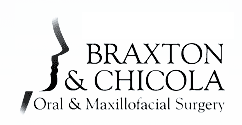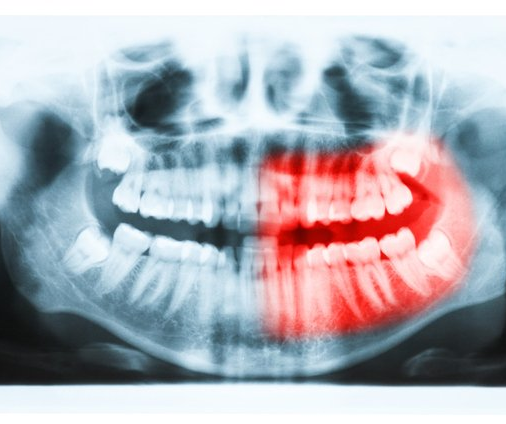Impacted Canine
IMPACTED CANINE SERVICES FOR PENSACOLA, FL
Exposure and Bracketing of an Impacted Canine
An impacted tooth simply means that it is “stuck” underneath the gums and/or the jawbone and cannot erupt properly. Patients frequently develop problems with impacted third molar (wisdom) teeth. These teeth get “stuck” in the back of the jaw and can develop painful infections among a host of other problems.
Since there is rarely a functional need for wisdom teeth, they are usually extracted if they develop problems. The maxillary canine (upper eye tooth) is the second most common tooth to become impacted. The canine tooth, however, is a critical tooth in the dental arch and plays an important role in your “bite.” The canine teeth are very strong biting teeth and typically have the longest roots of any human teeth. They are designed to help guide the rest of the teeth into the proper bite during chewing. Normally the upper canine teeth are the last of the “front” teeth to erupt into place. They usually come into place around age 13, and cause any remaining space between the upper front teeth to close. If a canine tooth gets impacted, every effort is made to get it to erupt into its proper position in the dental arch. The techniques involved to aid eruption can be applied to any impacted tooth in the upper or lower jaw, but most commonly they are applied to the upper canine teeth. Some of these teeth may be located on the palatal aspect of the upper jaw (roof of the mouth), some are in the middle of the supporting bone but stuck in position above the adjacent teeth, and the remainder are positioned on the facial (outer side) of the dental arch
EARLY RECOGNITION OF IMPACTED TEETH IS THE KEY TO SUCCESSFUL TREATMENT
The older the patient, the more likely an impacted canine tooth will not erupt by nature’s forces alone, even if the space is available for the tooth to fit in the dental arch. The American Association of Orthodontists recommends that a screening X-ray along with a dental examination be performed on all dental patients around seven years of age to count the teeth and determine if there are problems with eruption of any of the adult teeth. It is important to determine whether all the adult teeth are present or if some adult teeth are missing.
- Are there extra teeth present or unusual growths that are blocking the eruption of the eye tooth?
- Is there extreme crowding or too little space available causing an eruption problem with the eye tooth?
The initial exam is usually performed by the general dentist, who will often refer the patient to an orthodontist if a problem is identified. Treating such a problem may involve an orthodontist placing braces to open spaces to allow for proper eruption of the adult teeth. Treatment may also require a referral to an oral surgeon for extraction of retained baby teeth (those that should have already been lost) and/or selected adult teeth that are blocking the eruption of the canine teeth. Many times, it is also necessary to remove any "extra" teeth (supernumerary teeth) or growths that are blocking eruption of any of the adult teeth. If the eruption path is cleared and the space is opened up by age 11 or 12, there is a chance the impacted canine tooth will erupt without further intervention. If the canine tooth's development is more complete (age 13-14), the impacted tooth often will not erupt by itself even with the space cleared for its eruption. If the patient is too old (over 40), there is a much higher chance the tooth will be permanently fused in its impacted position. In these cases, the tooth will not budge despite all the efforts of the orthodontist and oral surgeon to erupt it into place. The best option at this point is generally to extract the impacted tooth and consider an alternate treatment to replace it in the dental arch (crown on a dental implant or a fixed bridge).
Occasionally, teeth other than the canine teeth will remained impacted. The same surgical steps can be taken to help these teeth erupt as well. The specific details of these cases may vary more widely, and the individualized surgical plan for your case will be reviewed in detail at your consultation visit.
WHAT HAPPENS IF THE CANINE TOOTH WILL NOT ERUPT ONCE PROPER SPACE IS AVAILABLE?
In cases where impacted teeth will not erupt spontaneously, the orthodontist and oral surgeon work together to help these teeth erupt into the desired position. Each case must be evaluated on an individual basis, but treatment will usually involve a combined effort between the orthodontist and the oral surgeon. The most common scenario will call for the orthodontist to place braces on the teeth (at least the upper arch). A space will be opened to provide room for the impacted tooth to be moved into its proper position in the dental arch. If the baby canine tooth has not fallen out already, it is usually left in place until the space for the adult canine tooth is ready. Once the space is ready, the orthodontist will refer the patient to the oral surgeon to have the impacted canine tooth surgically exposed and bracketed. In a simple surgical procedure performed in the surgeon’s office, the gum tissues on top of the impacted tooth will be lifted up to expose the hidden tooth underneath. If there is a baby tooth present, it will be removed at the same time. Once the tooth is exposed, the oral surgeon will bond an orthodontic bracket to the exposed tooth. The bracket will have a small chain or wire attached to it. The oral surgeon will guide the chain back to the orthodontic arch wire where it will be temporarily attached. Sometimes the surgeon will leave the exposed impacted tooth completely uncovered by suturing the gums in a higher position relative to the tooth or making a window in the gum covering the tooth (on selected cases located on the roof of the mouth). Most of the time, the gum tissue will be returned to its original location and sutured back with only the chain remaining visible as it exits a small hole in the gum tissue.
Shortly after surgery (1-14 days) the patient will return to the orthodontist. A rubber band will be attached to the chain to put a light eruptive pulling force on the impacted tooth. This will begin the process of moving the tooth into its proper place in the dental arch. This is a carefully controlled, slow process that may take up to a full year to complete. Remember, the goal is to erupt the impacted tooth and not to extract it! Once the tooth is moved into its final position in the dental arch, the gum tissue around it will be evaluated to make sure it is sufficiently strong and healthy to last for a lifetime of chewing and tooth brushing. In some circumstances, especially those where the tooth had to be moved a long distance, there may be some minor “gum surgery” required to add bulk to the gum tissue over the relocated tooth so it remains healthy during normal function. Your dentist or orthodontist will explain this situation to you if it applies to your specific case.
WHAT TO EXPECT AFTER SURGERY TO EXPOSE AND BRACKET AN IMPACTED TOOTH?
The surgery to expose and bracket an impacted tooth is a very straightforward surgical procedure that is performed in the oral surgeon’s office. Anesthesia ranges from local anesthesia to IV general anesthesia, depending on patient age, health, and anxiety level. These issues will be discussed in detail at your pre-operative consultation with your doctor. You can expect a limited amount of bleeding from the surgical sites after surgery. Although there will be some discomfort after surgery at the surgical sites, most patients find Tylenol or Advil to be more than adequate to manage any pain they may have. When needed pain prescriptions will be provided. Within 2-3 days after surgery there is usually little need for any medication at all. There may be some swelling noted in the upper lip after surgery, and this can be minimized by applying ice packs to the lip for the afternoon after surgery. A soft, bland diet is recommended at first, but you may resume your normal diet as soon as you feel comfortable chewing. It is advised that you avoid sharp food items like crackers and chips as they will irritate the surgical site if they jab the wound during initial healing. Your doctor will see you 7-10 days after surgery to evaluate the healing process and make sure you are maintaining good oral hygiene. You should plan to see your orthodontist within 1-14 days to activate the eruption process by applying the proper rubber band to the chain on your tooth.




